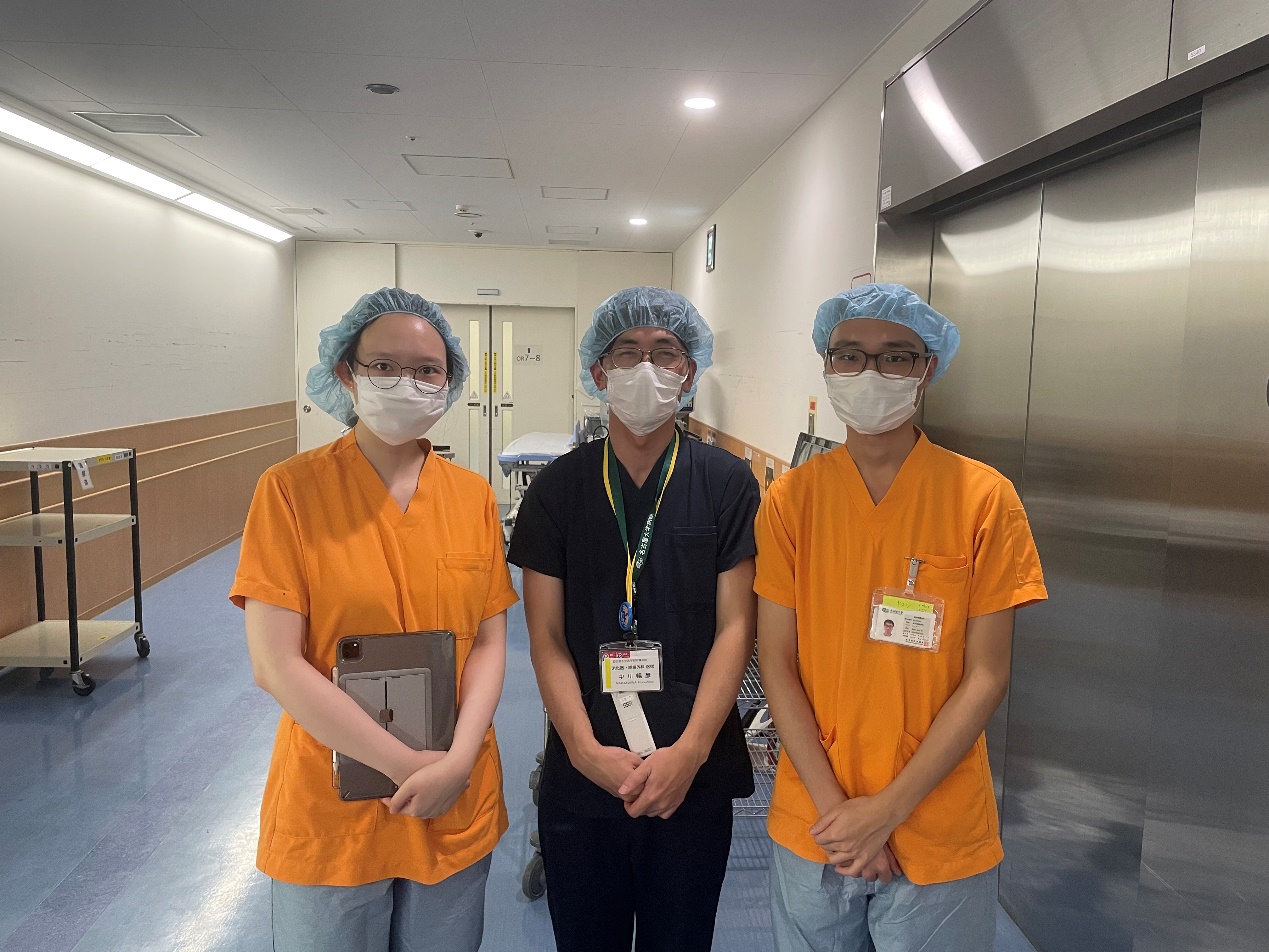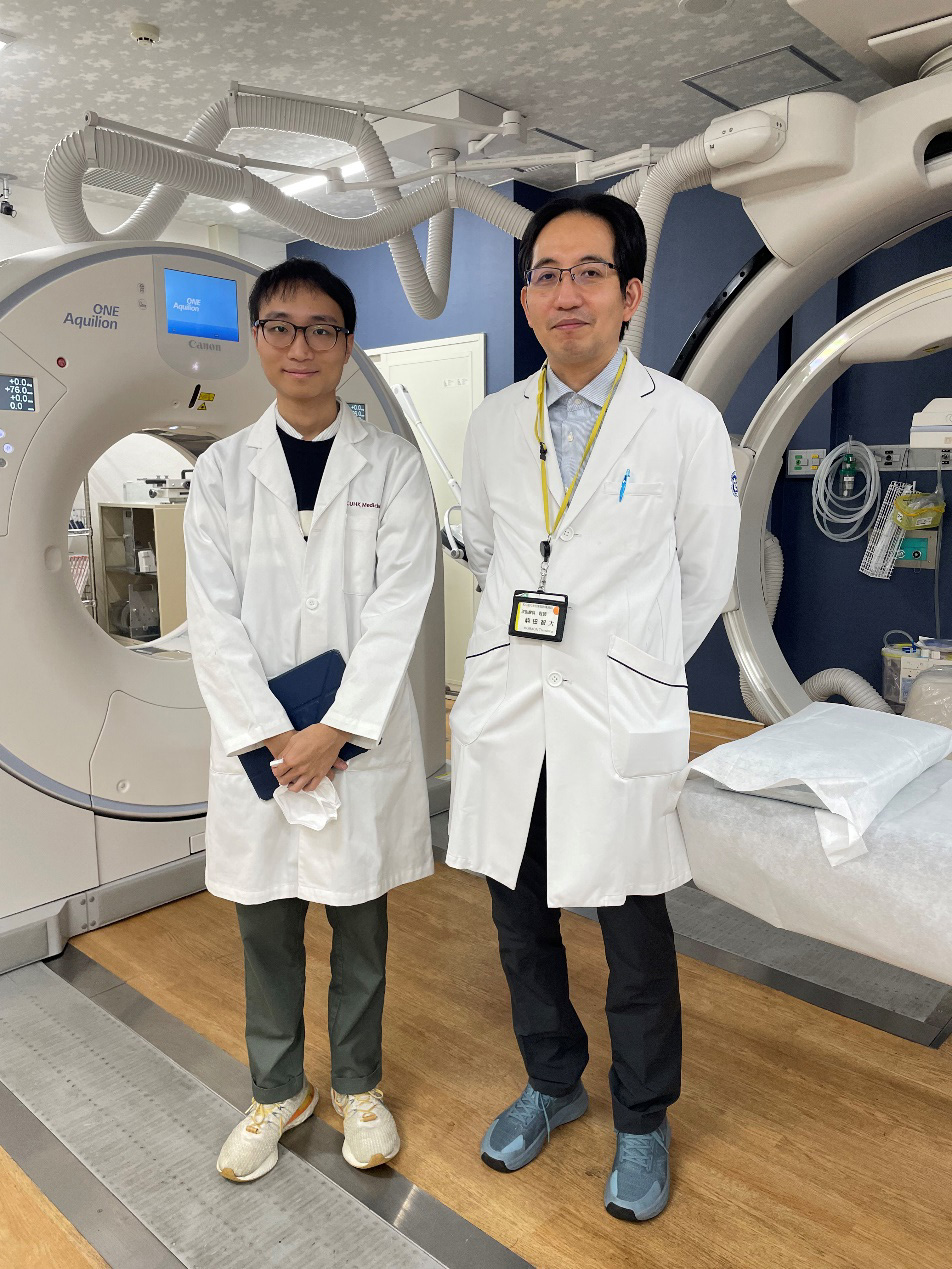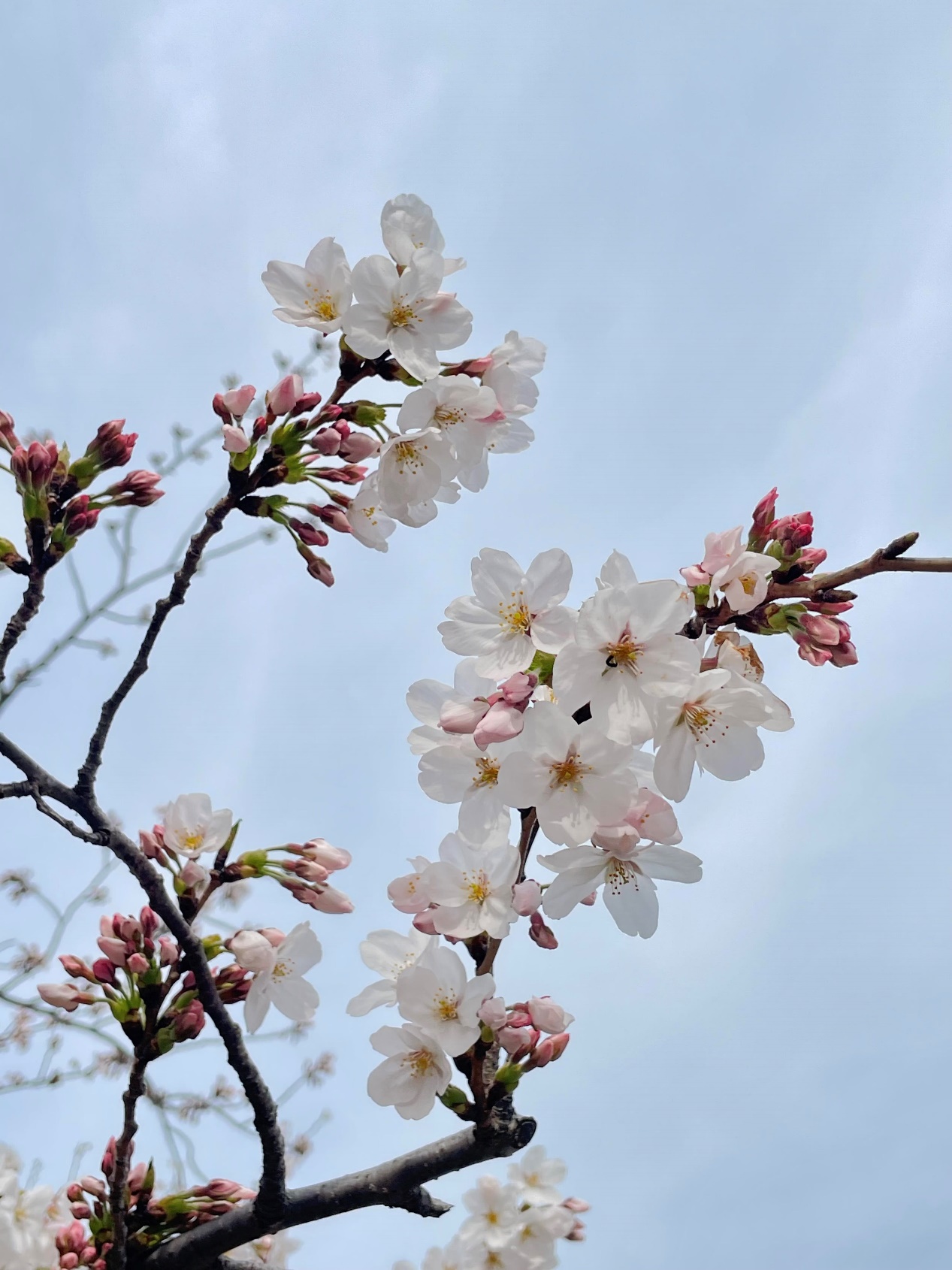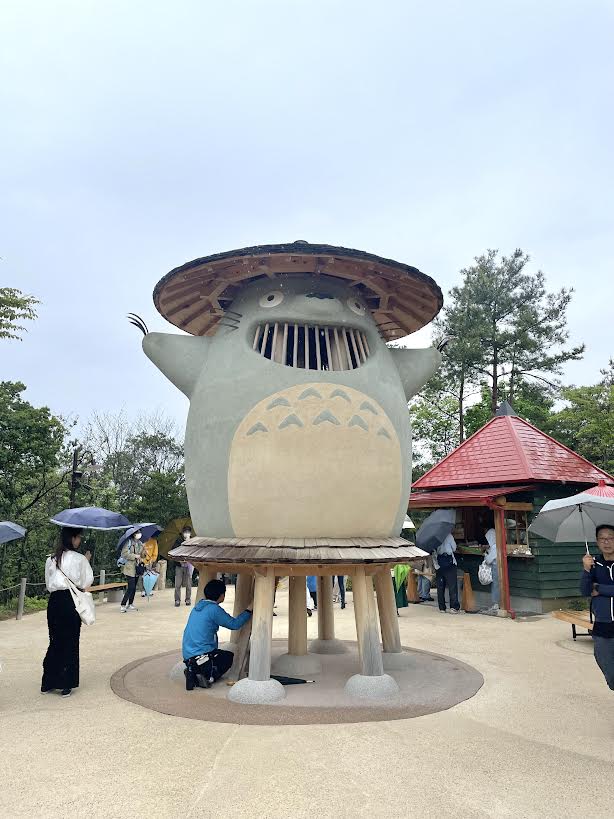Clinical Exchange in Japan
Welcome to Japan and Nagoya University school of Medicine!
Experience report
Name: WONG Hong Ki
School: The Chinese University of Hong Kong
Study Period: Apr 1st to Apr 26th, 2024
Departments: Surgical Oncology, Radiology
From the 1st of April, have finished a four-week attachment in the department of radiology and the department of surgical oncology in Nagoya University, Japan. The visit was fruitful and unforgettable in a way that I yielded unexpected gain in addition to fulfilling my objectives.
Objectives of the elective
Unlike some of my prospective colleagues in Hong Kong, I am not yet dedicated myself into a certain career path for the future. What I can tell is that as a medical student with a keen interest in pursuing a career in surgery, the elective was a precious opportunity to deepen my practical and theoretical understanding of surgical practices. Through observing various surgical procedures and understanding the intricacies involved in surgical planning, I shall seek to consolidate my interest and decision to specialize in surgery.
Second, as one of the regions suffering from aging population just like Hong Kong, Japan is internationally recognized for its advanced elderly care, including cancer management techniques. The country has made significant successes in integrating cutting-edge technologies and multidisciplinary approaches to cancer care, such as surgery, radiation therapy and chemotherapy. Therefore, I was particularly interested in exploring both Japan’s current healthcare environment and their curriculum for medical students to understand how Japan's healthcare system evolves to meet the increasing cancer incidence under aging population, which shall provide me valuable insights into global healthcare trends.
Third, radiology plays a pivotal role in modern medicine from screening, diagnosis to therapy. It also plays an inalienable role in surgical planning, which I see the necessity to familiarize myself with if I were to pursue surgery. My objective was to gain a thorough understanding of the duties and scope of radiologists, including their role in diagnostic imaging and therapeutic procedures. I believed the experience would be helpful for a future surgeon to effectively collaborate with radiologists and enhance patient care through precise diagnostic and therapeutic strategies.
In addition, Japan's medical system substantially differs from Hong Kong’s system with the presence of National Health Insurance program. I hoped to explore how Japan’s system operates, its merits and shortcomings, and how it compares to Hong Kong’s healthcare system. Understanding these differences shall allow me to appreciate the diversity in healthcare delivery models and their impact on patients.
Last but not least, Hong Kong and Japan have different cultural foundations, which translate into different modes and patterns doctor-patient interactions in clinical contexts. I sought to explore the cultural aspects in clinical practice in Japan, particularly their unique chemistry in doctor-patient relationships, the atmosphere in hospitals, and the overall working environment. This cultural immersion would help me develop a more empathetic approach to patient care.
Activities carried out to fulfil the objectives
During my exchange, I had the opportunity to observe a variety of surgeries within the field of general surgery, including lower, upper gastrointestinal and hepato-biliary-pancreatic surgeries. This experience allowed me to see the meticulous planning and teamwork required in surgical procedures. I also observed the use of advanced techniques such as the Kimura procedure in spleen-preserving distal pancreatectomy, and application of robots in esophagectomy, which broadened my understanding of modern surgical practices.
Besides, I also got the chance to attend tutorials and lecture designed for the local students. This offered me an opportunity to take a glimpse into their educational system and teaching methods. I participated interactive discussions and case studies covering a range of topics from basic medical sciences to clinical cancer treatment plan formulation. Also, I participated in routine meetings with doctors and observed how doctors from different specialties approach cancer patients from different perspectives.
Furthermore, my participation in ward rounds and consultations were invaluable experiences to observe doctor-patient communication in the daily routines of healthcare professionals in Japan. I noted the differences in communication styles, bedside manners, and the public impression of healthcare professionals reflected in the actions and responds from patients, and vice versa.
During the radiology rotation, I was offered the chance to shadow multiple radiologists for their daily routine. The experience gave me a comprehensive view of their daily responsibilities, including interpreting diagnostic images, performing nuclear medical procedures and interventional procedures. I also got hands-on opportunity to learn and try to formulate a radiation therapy plan for a breast cancer case.
During the off-school time, I took the chance to engage in social activities with local students, which allowed me to build connection and appreciate Japanese culture and lifestyle. Not only did we compared our curriculum as medical students, but we also discuss the similarities and differences between our own healthcare systems. These interactions provided me a broader understanding on the social dynamics and cultural values that influence doctors and patients’ behavior in Japan.
The knowledge and skills learnt
Through observing surgeries, I learned about different surgical techniques and procedures. Luckily, the doctors I met were easy-going and were passionate to spend time chatting with me and my exchange student buddy who came from Korea and happened to be attaching at the same specialty as me. We learnt about the leading trends of modalities in treating different types of cancer, the rationale and challenges behind in every surgical plan, as well as the procedure of various surgeries and the anatomical structures to be treated with care. Apart from the technical and factual knowledge, the experience also illustrated the importance of precision, teamwork and in enhancing surgical outcomes, as the profound collaboration between healthcare professionals of different roles from before, during, to after the surgical procedures are critical for a successful surgical treatment. This attachment demonstrated to me that those happening in the operation theatre is just the tip of the iceberg of surgery.
My stay at the radiology department was rather fruitful too. One of the most valuable skills I got to polish was the ability to interpret radiological images. I was able to get individual tutorials from different radiologists responsible for interpreting images of different modalities, including CT, MRI and PET-CT. This skill is essential for surgeons, as it aids preoperative planning, intraoperative decision-making, and postoperative assessment. On top of the common features of different pathologies on the images, I also learnt able the latest developments in the diagnostic application of radiology, for example the standing CT, and how it compares to regular CT. This expertise will undoubtedly enhance my diagnostic capabilities and contribute to better surgical planning and patient care in the future. From the therapeutic perspective, I got to learn about the history and development of radiation therapies, the different modes and technologies ranging from brachytherapy to proton beam therapy, and their corresponding advantages and disadvantages. Joining routine meetings of the department also enabled me to analyze cancer patients from the radiologists’ perspective, which I believe such experience would come in handy for me to cooperate with radiologists as a future surgeon. The rotations to nuclear medicine and interventional radiology were also enjoyable, and I was able to familiarize myself with different indications of different nuclear medicine strategies and interventional procedures.
Throughout the elective, I noticed the extensive integration of multidisciplinary strategies on cancer patient management. I observed how different specialties collaborate to create comprehensive treatment plans, ensuring that patients receive holistic care. It was also interesting to hear that Japan provide well-established curriculum about oncology and different adjuvant and neo-adjuvant techniques for medical students to prepare for future challenges of their country.
Moreover, understanding the differences between Japan's healthcare system and that of Hong Kong was an eye-opening experience. Japan's national health insurance ensures comprehensive coverage and equitable access to healthcare services for their citizens. It seems to be an attractive system for the public as it significantly reduces the out-of-pocket expenditures, but the financial pressure is in turn added onto the government, who’s facing the challenge of shrinking taxation income from aging population. There are numerous other differences in the healthcare system between two regions, such as there is negligible public-private disparity in Japan’s hospital, unlike Hong Kong. On the other hand, the two systems possess similarities in various aspects, including the suboptimal development of primary care services. Comparing the healthcare systems of two regions highlighted the strengths and challenges of different models of healthcare delivery. This knowledge shall inform my future practice and help me advocate for improvements in healthcare systems.
Apart from fulfilling my own objectives, I also learnt about the Korean healthcare environment and their situation with the ongoing protest, which was completely out of the blue. Coincidentally, there was another student from Korea who was attaching to the surgical department, so we stayed together during that rotation. It was always inspiring to have people from three different places together chitchatting their homelands during lunch hours.
Personal and/or professional insights and reflections gained from the elective
I am rather satisfied to find myself being able to appreciate the beauty of surgical stream during the elective. I was fascinated by the dedication and effort that doctors had put into the preparations before the surgery to ensure everything would proceed according to the plan. It is almost like creating a piece of art. I believe the elective has made me more inclined towards pursuing surgical streams in my future career.
This elective was an enriching that it went beyond academic learning. Immersing myself in Japanese culture, both inside and outside clinical settings, broadened my perspective and deepened my appreciation for cultural diversity. The experience of living in a different country and building cross-cultural relationships has made me more adaptable and open-minded. The doctor-patient relationship in Japan is characterized by a high level of respect, patience, and attentiveness. It was interesting to notice that the attitude of Japanese doctors towards their patient is milder and humbler, almost to the extent that it is their pleasure to be able to treat their patients, whereas in Hong Kong, doctors generally hold stronger authority and power, there seems to be a much clearer hierarchy in doctor-patient relationships. Of course, doctors have high socioeconomic status and are respected in both regions, but the natures and origins of the respect absolutely differ. I could suspect that such differences originate from the different traditional, historical, and cultural foundations of the two places. Observing these interactions taught me valuable lessons about different modes of doctor-patient communication, empathy, and patient-centered care. I aim to incorporate these practices into my future career to enhance patient outcomes while encountering different situations and challenges.
Finally, this exchange opened my eyes to potential career opportunities overseas. It was inspiring to see people around the world working out similar while different solutions toward the same medical problems, and through research, exchanges and discussions shall we combine our achievements together to push the advancement of modern medicine. Thus, international fellowships or training programs shall interest me in the future and the global perspective gained through this exchange will also be instrumental in shaping my professional aspirations and expanding my career horizons.
Off-school leisure activities
I took my time to go sightseeing during weekends. Since it was my first time visiting to Nagoya, there was a lot for me to explore in the city. In addition to visiting the traditional, well-known tourist attractions like Atsuta Jingu, Nagoya Castle, Toyota Museum and Inuyama Castle, I also spent my time at the science museum, Higashiyama Zoo, and the Ghibli Park. As a person who love Japanese cultures and artworks, being able to travel in Japan was just a total enjoyment.
In comparison to large tourist attractions, there are many small shrines and temple, small historical artifacts and sculptures scattered around the city. It was striking for me to witness the emphasis and effort Japan has put in to preserve its cultural and historical heritage while seamlessly integrating them within the modern cityscape. This blend of old and new not only preserves the rich cultural legacy but also enriches the urban environment. Observing this thoughtful integration highlighted the success of Japan in transforming itself into a developed country with world-leading live standards while not relinquishing its respect for its history and cultural identity.




Click here to read other stories
Nagoya University Graduate School of Medicine